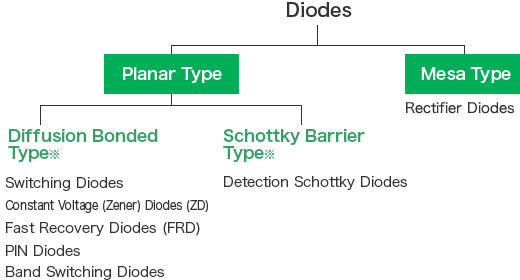Outline of a Diode <Classification>
Diodes can be classified by the functions of the circuit in which it is being used, or more commonly, by the shape that is demanded by the size of the products in which it will be mounted. The complicated point is that there is no direct relation between the two and you must keep them both in your mind at all times.
However, you can think of the function as the base, and since this function can then be supported by many different shapes, it can then be further classified by those shapes.
Classification by the Working Frequency
This is the most basic classification. Diodes are classified according to their characteristics and are offered in a number of different types, including rectifiers, switching diodes, Schottky barrier diodes, Zener (constant voltage) diodes, and diodes designed for high-frequency applications. And although constant voltage Zener diodes are generally used as protection elements, with the increasing precision of peripheral circuits and greater miniaturization of protection applications comes a need for TVS protection elements that provide greater performance.

Classification by Structure
If we classify by structure, it allows classification by the different configurations of the diode elements. Currently, the main constructions are the flat planar diode types and high breakdown voltage mesa diode types.

Planar Type

Today, the most popular method for creating a semiconductor junction is forming an oxidized layer on a silicon substrate, opening holes in the required locations, and then introducing impurities into the holes for a diffused junction. Since the oxidized membrane on the silicon is resistant to the introduction of the impurities, the junctions can be made at only the required locations. Also, the portions of the surface of the silicon substrate where the junctions can occur are protected by this oxidized membrane for a structure that is very resistant to external contaminants.
By introducing impurities (boron or phosphorous) to the silicon semiconductor by heat diffusion (by causing the impurities to permeate into the semiconductor with high temperatures), this type of diode refers to a configuration where both the p-type and n-type regions are diffused with impurities. At the junctions, a type of barrier called an electric potential barrier is formed, and this barrier produces the rectification for the electrical current.
Schottky barrier diodes make use of the electric potential barrier formed at the junction between metals and semiconductors. The knowledge that rectifying properties were present at the junctions between metals and semiconductors has been around for a long time, but the man that theoretically explained the phenomenon was a physicist named Walter Schottky, and this structure now bears his name. Compared to the pn junction of a diffused-junction rectifier, there is no storage of minority carriers and the reverse recovery time is extremely short. This enables an excellent efficiency for rectification in high frequencies, a low forward voltage (Vf), and a minimal amount of power loss. This is why Schottky diodes are often used in applications for high frequency rectification.
Mesa Type

With a structure that is shaped like a geological mesa, this configuration allows for very large breakdown voltages (Vr). This is the reason mesa diodes are often used for rectification purposes. However, even though the breakdown voltage can be made very high, since the structure causes the pn junction to be exposed, the reverse current (leak current) is often much larger (worse) than that for planar diodes. For Rohm, the MSR, GSR, and RLR are diodes of this configuration.
Classification by Forward Current
When classifying diode by their forward current (IF), those with a forward current (IF) of less than 1 ampere are called small-signal diodes, and those with a forward current (IF) of 1 ampere or more are called Middle Power / Power Diodes.

Classification by Integration
One of the strong points of ROHM is that it offers diode arrays. Opposed to discrete types, diode arrays are an integration of many diodes.

Classification by Shape
Diodes come in many different shapes to accommodate different packages, mounting types, and functions. The two major types are the lead type and the surface mounting type.






